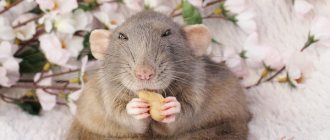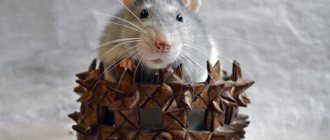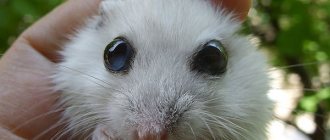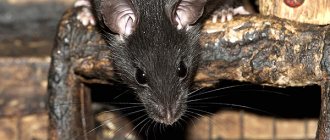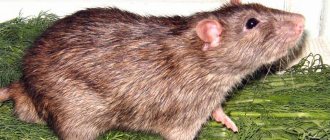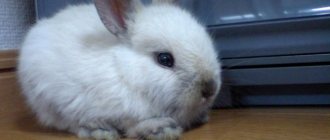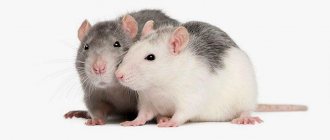What is it really like to have a pet rat? Owning a pet rat is a wonderful experience if you have the time to care for them. These rodents are especially active at night and are very social, and you should keep this in mind when deciding whether you should get a pet rat. But let's take a closer look at the pros and cons of owning a pet rat.
Benefits of rats as pets
- Rats are highly intelligent
They can learn tricks and commands such as fetching things for you, answering their name, etc. These rodents can also solve puzzles and collect treats you have hidden. There are even pet rats that are trained to find mines for the military. They are also very easy to litter train, making cleaning up after them much easier.
- Domestic rats are clean
They spend most of their day simply licking and preening themselves. This makes caring for them much easier. As mentioned earlier, they can also be litter box trained.
- They are inexpensive
If you are on a tight budget, a rat may be the perfect pet for you and your family. They are also inexpensive to care for. The owner will have to spend money on a cage and a few toys for them, but overall rats are pretty inexpensive.
- These rodents do not require special care
They don't need walks, they very rarely need grooming, and although their diet should be healthy and varied, there are relatively few foods that they cannot eat. And being active at night, they don't mope when their owner goes to school or work - they just sleep.
Most of the work you will have to do is cleaning their cage from time to time and changing their litter box to keep the room and cage odor-free. They also need attention, but this applies to all pets.
- They are very affectionate and easily get attached.
Not only among themselves, but also with their owners. In fact, domestic rats recognize their owner very easily using different senses. They will actively search and play with other rats and you. Pet rats will also sleep together almost all the time.
They enjoy cuddling with you, playing with your hands and enjoying being petted if they are used to it from an early age. They even do something called "bruxing." Pets chatter their teeth to show their love for you.
But the degree of their affection depends on several things. If they are not yet used to you, they may appear skittish and run away from you. You need to gain your pets' trust by giving them treats, spending some time with them, letting them get to know you better, and so on.
This is why it is so important to pay attention to your pet rat!
Not only will they become more affectionate by spending more time with you, but they will also feel happier. Pet rats are extremely susceptible to depression, which most often occurs due to not receiving enough attention for a long time. This happens quite often, especially if you only have one rat (which you shouldn't do, always get a pair).
The way you express love also depends on the gender of your rat. Male pet rats tend to be lazier and want to cuddle more often. While female rats are often more energetic, very curious and always on the move, they will often need to play with you.
- Pet rats make great first pets for children
Since they are fairly low-maintenance pets, they are ideal for small children. It will be easy for the child to learn to take care of them. By caring for a rodent, children will be able to learn about the responsibility of having a pet and will have a buddy with whom they can chat at any time.
- Each rat has its own personality
They are very emotional and react to things differently. For example, some pet rats will love to chew on toys and will destroy and chew on everything. While others will want to run after balls and push them. Some people will enjoy being picked up and riding on your shoulders. Others will just want to lie on your lap and sleep. There are many different pet rats, and you never know which one will be yours.
- Rats are not too big and not too small
They weigh between 200g (little girl) and 700g (big boy) at maturity and have a firm, robust body shape. This makes them quite easy to handle, even for children. But a couple of rats in a decent cage still doesn’t take up much space in the house.
Care and maintenance
This type of rodent was bred artificially, so it can only exist next to humans. And, naturally, it requires attention and knowledge on how to care for the rat Dumbo. The baby needs to immediately create suitable living conditions. The room where the little tenant will live should be bright and sunny. A cage for a decorative rodent should be placed at a height of 1-1.5 m from the floor, away from windows, radiators, stoves, and strong noise.
It should be made of metal rods (so as not to be chewed through like plastic ones) and with a deep tray. Size – quite large (minimum 40 x 30 x 50 cm). It is not recommended to use an aquarium for these purposes - it will be difficult to restore order there, plus there is no necessary ventilation. A mandatory accessory of the cage is the “house”. The pet will rest there. And all kinds of stairs and tunnels intended for entertainment are desirable, but not required. A ball drinker (not a bowl) and a fixed feeder are also necessary.
It is better to use corn, pressed sawdust (not very large in size), and paper as filler. Do not use cat litter, newspapers, or pine sawdust. You need to do “general cleaning” in the cage once a week, or more often. And the water needs to be changed every day. The temperature in the room where everyone's favorite lives should not exceed 30 degrees, but also not fall below 20 °C.
A cage for a decorative rat should not be in a draft or in direct sunlight - this has a detrimental effect on rodents.
Cons of decorative rats
- Rats don't sleep at night
This may be a minus for you, or it may be a plus. Depending on your schedule, you may be able to enjoy their company more. For example, if you work during the day and come home at night to relax, this could be a great opportunity to bond with your pet. On the other hand, if you work morning and afternoon and go to bed early, you may not have much time to enjoy the active company of your pet rat. But these rodents change their schedule to be more active when you're around, so take that into account.
- These rodents don't live long
Pet rats live between 2 and 3 years, so you should consider this when choosing one as a pet. It's quite a bit, and the time will pass faster than you think. Especially if you become emotionally attached to your pet.
- They get sick easily
They may have diseases quite common in rats, such as breathing problems, tumors and spinal problems. They will likely need medical care throughout their lives, so keep in mind that you will need to take them to the vet to address some of these issues.
- In most cases, male rats should not be kept with female rats.
Unless your pet rats are neutered, you should not allow mixed-sex rats to live together. Female rats can become fertile at 5 or 6 weeks of life, and in less than a month they can give birth to a litter of 10 small rats. Therefore, if you have pet rats of both sexes, you will need to either neuter them or keep them in separate cages.
- Pet rats need a lot of space to live.
We're not talking about tiny hamsters. Rats are slightly larger and will need a lot of space to live. This means that you will either have to buy a fairly expensive cage or build your own if you have the option.
- Rats need attention
Pet rats are very social and require daily attention. This is why you should always get more than one pet rat at a time. If they are left alone for a long time, they will become more and more depressed and may even die due to this.
- Pet rats love to chew
It mostly depends on the pet's personality, but the average pet rat will chew anything that interests it. It doesn't matter if it's a toy, a box, or your computer's power cord, they will chew through it. You have to either keep everything rat-proof or just keep an eye out for them.
Pros and Cons of Keeping Dumbo as a Pet
The decorative rat is one of those pets that does not require large expenses for its maintenance. Rats are curious and everyone wants to try their teeth. In addition, they require constant attention as they can fall and get hurt.
What attracts these animals is their developed intellectual abilities and lack of aggression towards humans and other animals.
The advantages of choosing Dumbo the rat as a pet include:
- cleanliness of the animal;
- omnivorous;
- low maintenance costs;
- ease of care.
But there are also disadvantages:
- the property of an animal to leave marks wherever it is;
- tendency to chew on any objects;
- expensive treatment;
- people with a keen sense of smell notice a specific smell that comes from domestic rats;
- for your pet to feel well, you need to devote a lot of time to it;
- walking is required;
- relatively short lifespan.
What will you need for the injection?
For injection, you need to prepare a syringe (preferably an insulin syringe, with a removable needle).
The owner of a rodent should keep a supply of disposable insulin syringes in his home medicine cabinet.
Injections to an animal can be done with the same syringe several times, just store the accessory in a clean place. Instead of an insulin needle, you can use a butterfly needle, the size is important - rats need blue (size 23G) and orange (size 25G).
Reproduction
How to determine gender?
Males can be distinguished from females by their enlarged testicles, which are clearly visible already at the age of 2–3 weeks. In female decorative rats, the rudiments of nipples are observed during this period of life.
Mating
Sexual maturity occurs early - at the age of 5–6 weeks. But individuals from 8 to 10 weeks are recommended for mating. In order to get offspring, it is enough to leave the male and female in the same cage for a couple of days. But you need to understand that fertilization is possible only if the female is in heat. It occurs regularly at intervals of 4–7 days.
Pregnancy
From the moment of fertilization to the birth of rat pups, no more than 23 days pass. On average, birth occurs between 21 and 23 days. The female's pregnancy becomes noticeable starting from the second week after fertilization. The animal’s physique plays a big role in the appearance of the first signs. If the female is thin, the rounded tummy will be noticeable faster than in a fat and large rat.
A litter can contain from 8 to 15 pups. During pregnancy, the female needs increased and nutritious nutrition. Bloody discharge and the female's desire for privacy will indicate the approaching birth . Often the dumbo rat begins to prepare its nest: it cleans and arranges it. Childbirth lasts no more than 3 hours.
How to care for newborn rat pups
The female Dumbo takes good care of her offspring.
During this period, the owner must follow several rules:
- do not pick up baby rats;
- take care of the cleanliness of the cell;
- provide the mother with good nutrition.
Rats can be handled once they are 14–15 days old.
Description of the rodent
Contrary to popular belief, the husky rat is not a distant relative of dogs of the same breed. The only thing that both representatives of the mammal class have in common is an interesting color with a characteristic white mask on the face. The husky rat was bred by Swedish breeders relatively recently - at the end of the 20th century. Today, these rodents are quickly gaining popularity among other pets.
Appearance
The main feature of the Husky rodent breed is the change in color throughout life. Newborn rat pups have darker fur, which becomes noticeably lighter with age.
The body parameters of husky rats are standard. On average, the length of an adult is 21-22 cm. Together with the scaly tail - 40-42 cm. Boys are noticeably larger than girls. The weight of a male ranges from 450-500 grams. The body weight of the female is 300-350 g.
Husky rat ears can have a standard shape and size. Or they can be round and set far apart, like representatives of the Dumbo breed. The darker the color at birth, the brighter the eyes. Their color can be red, bright ruby, or black.
Among Husky rats, as well as among dogs, there are sometimes individuals with eyes of different colors. Such animals are especially valued among professional breeders. However, this feature is not inherited.
Character and behavior
Husky rats are calm, good-natured animals. They quickly become attached to their owner and love spending time with him. Fluffies also build good relationships with their cage neighbors. Showdowns and fights between rodents are extremely rare. Quarrels sometimes happen during the mating season.
Representatives of this breed are also distinguished by their extraordinary intellectual abilities. For the most part, they respond to their names and are easy to train. Small animals, of course, will not be able to perform complex tricks like dogs. But simple commands are learned quickly.
Silvered colors
Silver can be any of the recognized colors, both solid and ticked. A distinctive feature of the colors of this section is the alternation of silver and colored hairs in equal quantities. Each silver hair should be as white as possible, although a colored tip is acceptable. Silver colors should give an overall impression of sparkle and shine. If there are a few white hairs interspersed, the color is not considered silver. The silveriness must be clearly expressed so that the silver color cannot be confused with pearl (Pearl) or any homogeneous (Self).
The belly color of silver agoutis and cinnamons should be judged according to the standard of homogeneous agoutis and cinnamons, but in a lighter variation. The belly color of other silver varieties should be consistent with the color as a whole.
Silvered Black
Dark charcoal color, as black as possible, with even interspersed silver hairs throughout the body. The eyes are black.
Silvered Blue
Gray-blue color with silvery-white hairs evenly distributed throughout the body. The undercoat is light bluish to almost white (as light an undercoat as possible is preferred). The eyes are black.
Silvered Mink
Smooth gray-brown color with a blue tint. The number of silvery and non-silvery hairs is equal. Each silver hair should be as white (or creamy silver-white) as possible, although a colored tip is acceptable. The eyes are black.
